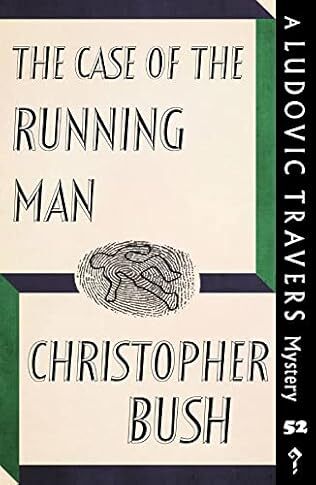The Case Of The Running Man

A review of The Case of the Running Man by Christopher Bush – 250622
The fifty-second novel in Bush’s long-running Ludovic Travers series, originally published in 1958 and reissued by Dean Street Press, sees his sleuth back in familiar territory, the art world. Other areas of familiarity are that the case takes Travers back to Mainford, where the earlier Case of the Red Brunette was based and we learn of the tax efficiency of buying and selling antiques. Also, as owner of the Broad Street Detective Agency, Travers walks a fine line between openly collaborating with the police in the form of Inspector Jewle and withholding certain information to protect client confidentiality, although the tension caused by this conflict is not as great as in other stories.
Travers is contacted is contacted by a rich eccentric, William Weddall, who intimates that he will probably have an important and sensitive job for him. At Weddall’s behest he goes to Paris just to post a letter for him and his interest in his new client is piqued when firstly he sees Weddall deliberately miss a boat train and then learns that he had plunged to his death from a window. Travers is contacted by Weddall’s American chauffeur, Sam Martin, who asks him to investigate the death of his employer as he is convinced that foul play was involved. It emerges that at the time of the death a man was seen running away from the crime and he had a distinctive mark, a scar on his chin.
Sam is a likeable and fascinating character, a man of colour with one of the strangest and unlikeliest of accents, a mix of Cockney and New York. It was pleasing to see that Bush has Travers tear a strip off his secretary for being racist towards Sam and although he is an employee Sam is clearly viewed by Weddall as a confidante and almost an equal. Bush portrays him as honest, caring, loyal and he is certainly one of the good guys, a refreshing change from the often, albeit casual, racism often found in Golden Age detective fiction.
As well as Weddall, Grace Amble, his housekeeper at Hinchbrook Hall, is also murdered, another victim who knew too much and tried unwisely to profit from that knowledge. Weddall seems to have made a discovery. With his eyesight failing he believes that he is being scammed and that the paintings which he assumed were valuable are not quite what they seem. He has been the victim of a fraud not unlike that which forms the main premise of Freeman Wills Crofts’ earlier Golden Ashes.
It is a case of a will about to be changed, a desperate need for cash, and a fear of discovery. The most obvious suspect appears to have cast-iron alibi, especially as suspicion can be diverted to the man who was seen fleeing the scene of the crime. The alibi involves the most familiar of detective fiction tropes but the twist is delightful, a piece of childish mischief providing an unexpected boon which the suspect gladly accepts with both hands. I also enjoyed the motif of a cat and mouse which echoed the last book I had read.
As we come to expect with Bush, the plot is ingenious and tight and while the book misses much of the tension that Travers’ fraught relationship with George Wharton once brought, it is an engaging and fascinating read, made even more memorable by the sympathetic treatment of Sam Martin. Bush may be an irritating stuck-in-the-mud old Tory at times but his heart is often in the right place.



